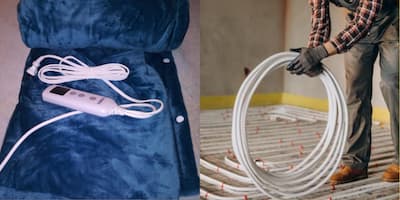
Choosing the ideal heating option to keep warm and comfortable during colder months is crucial. Electric blankets and radiant floor heating are two popular choices worth considering. In this blog post, we’ll compare these options to help you make an informed decision based on your specific needs and preferences.
We’ll explore the functionality, pros and cons, and suitability of electric blankets and radiant floor heating. Factors such as comfort, energy efficiency, safety, installation requirements, and more will be discussed. By the end, you’ll have the insights necessary to select the heating solution that best fits your lifestyle and budget.
Join us as we delve into the world of electric blankets and radiant floor heating, uncover their unique characteristics, and determine which option offers the warmth and comfort you desire. Let’s find out which is the better choice for you.
Why Use Electric Blankets
Electric blankets are blankets that incorporate heating elements, allowing users to adjust the level of warmth they provide. These blankets are typically equipped with electrical wires or heating coils that distribute heat evenly across the surface. They are designed to be used on top of a regular bedsheet or underneath a comforter.
Pros and Cons
1. Comfort and Convenience
Electric blankets offer direct warmth to the user, providing a cozy and comfortable experience. They can quickly warm up a bed or provide targeted heat to specific areas of the body. Most electric blankets come with adjustable temperature settings, allowing users to customize their level of warmth according to personal preferences.
2. Energy Efficiency
Compared to heating an entire room, electric blankets can be more energy-efficient. By directly heating the bed and the user, they reduce the need to heat the entire sleeping area, potentially leading to energy savings.
3. Safety Considerations
While electric blankets are generally safe, it is essential to follow manufacturer instructions and guidelines. Look for blankets with built-in safety features such as automatic shutoff timers and overheat protection. It’s crucial to regularly inspect the blanket for any signs of damage or wear and tear.
Suitability for Different Situations
1. Personal Use
Electric blankets are particularly useful for personal use, providing individualized warmth during colder nights. They can be ideal for individuals who prefer different temperature settings than their sleeping partners.
2. Specific Health Conditions
Electric blankets can be beneficial for individuals with certain health conditions, such as arthritis or muscle pain. The controlled heat from the blanket can help soothe aches and promote relaxation.
3. Cost Considerations
Electric blankets can be a cost-effective heating option, especially when compared to heating an entire room. They provide localized warmth, allowing users to reduce heating costs by focusing the heat where it’s needed most.
Why Use Radiant Floor Heating

Radiant floor heating is a method of heating that involves installing heating elements, such as electric cables or water-based pipes, beneath the floor surface.
The heat radiates upward from the floor, providing an even and comfortable warmth throughout the room.
Let’s look into the pros and cons of using this type of heating.
Pros and Cons
1. Even and Consistent Heat Distribution
Radiant floor heating ensures uniform heat distribution across the entire floor area, eliminating cold spots and creating a comfortable environment. The heat rises from the floor, warming objects and people in the room without relying on forced air circulation.
2. Energy Efficiency
Radiant floor heating can be highly energy-efficient. By heating the floor directly, it minimizes heat loss and reduces energy consumption compared to traditional heating systems. It also eliminates the need for ductwork, which can be a source of heat loss in forced-air systems.
3. Installation and Maintenance Requirements
Installing radiant floor heating can be a complex process, especially for retrofitting existing buildings. It often requires professional installation and may involve lifting or replacing the existing flooring.
Maintenance requirements are generally minimal once the system is installed correctly.
Suitability for Different Situations
1. Home Heating
Radiant floor heating is well-suited for residential heating applications. It provides consistent warmth throughout the entire home, ensuring comfort in every room. It is particularly beneficial for rooms with hard flooring surfaces, such as tile or stone, which can be cold to the touch.
2. Climate Considerations
Radiant floor heating is especially advantageous in colder climates. The radiant heat can help counteract cold drafts and keep the floor surface warm, providing a comfortable living environment even during frigid winters.
3. Long-Term Cost Analysis
While the upfront installation costs of radiant floor heating can be higher compared to other heating systems, it can offer long-term cost savings. The energy efficiency and reduced heat loss associated with radiant floor heating can result in lower energy bills over time.
When looking for heating methods, whether it’s for home heating, considering the climate or evaluating long-term cost savings, radiant floor heating offers an efficient and comfortable heating solution for various scenarios.
Comparison and Considerations
When deciding between electric blankets and radiant floor heating, it’s important to consider various factors to determine which option is better suited for your needs.
Let’s explore some key points for a good comparison:
A. Comfort and warmth
Both electric blankets and radiant floor heating offer different experiences of comfort and warmth. Electric blankets provide direct warmth to your body while you sleep, allowing for customizable temperature settings.
Radiant floor heating, on the other hand, offers consistent warmth throughout the entire room, making the floor cozy to walk on. Consider your preferences for localized warmth or overall room comfort when assessing comfort levels.
B. Energy Efficiency and Cost-Effectiveness
Energy efficiency is a significant consideration when it comes to heating options. Electric blankets can be energy-efficient by directly heating the bed area, minimizing energy consumption.
However, radiant floor heating systems are known for their high energy efficiency, as they utilize radiant heat and minimize heat loss. While the upfront costs of installing radiant floor heating can be higher, it may provide long-term cost savings in terms of reduced energy bills.
C. Safety Aspects
Safety is paramount when choosing a heating solution. Electric blankets should be chosen with safety features like automatic shutoff timers and overheating protection.
On the other hand, radiant floor heating systems do not have exposed heating elements, reducing the risk of burns or accidents. Ensure that your chosen option meets safety standards and guidelines.
D. Installation and Maintenance Requirements
Consider the installation and maintenance requirements of each option. Electric blankets are relatively easy to set up and require minimal maintenance beyond regular cleaning and safety checks.
Radiant floor heating, however, requires professional installation and may involve lifting or replacing the flooring. Once installed, radiant floor heating systems typically require little maintenance.
E. Flexibility and Versatility
Evaluate the flexibility and versatility of each option. Electric blankets offer portability, allowing you to use them in various locations, such as different beds or even when traveling.
Radiant floor heating, on the other hand, is a permanent heating solution integrated into the floor of your home. Consider whether portability or a fixed heating system aligns better with your needs.
F. Personal Preferences and Lifestyle Factors
Finally, consider your personal preferences and lifestyle factors. Reflect on your heating habits, the size of the space you need to heat, and your overall lifestyle.
If you have specific health conditions that benefit from localized heat, an electric blanket might be more suitable. If you desire a long-term heating solution for your home with consistent warmth throughout, radiant floor heating could be the better choice.
With this in mind, the comparison between electric blankets and radiant floor heating, both options offer unique benefits and considerations. The decision ultimately depends on your specific needs and preferences.
Electric blankets provide personal comfort and convenience, allowing for customizable warmth and energy efficiency. They are suitable for individual use, catering to different health conditions and cost-effective heating.
Radiant floor heating offers even warmth throughout the room, energy efficiency, and a long-term heating solution for your home. Although installation costs may be higher, the potential for reduced energy bills and increased comfort makes it an attractive option.
Consider factors such as comfort, energy efficiency, safety, installation requirements, flexibility, and personal preferences when making your decision. Prioritize safety and follow manufacturer guidelines.
Stay warm and cozy with the heating option that aligns with your lifestyle and budget.
Read more on how to choose the best electric blankets here.
